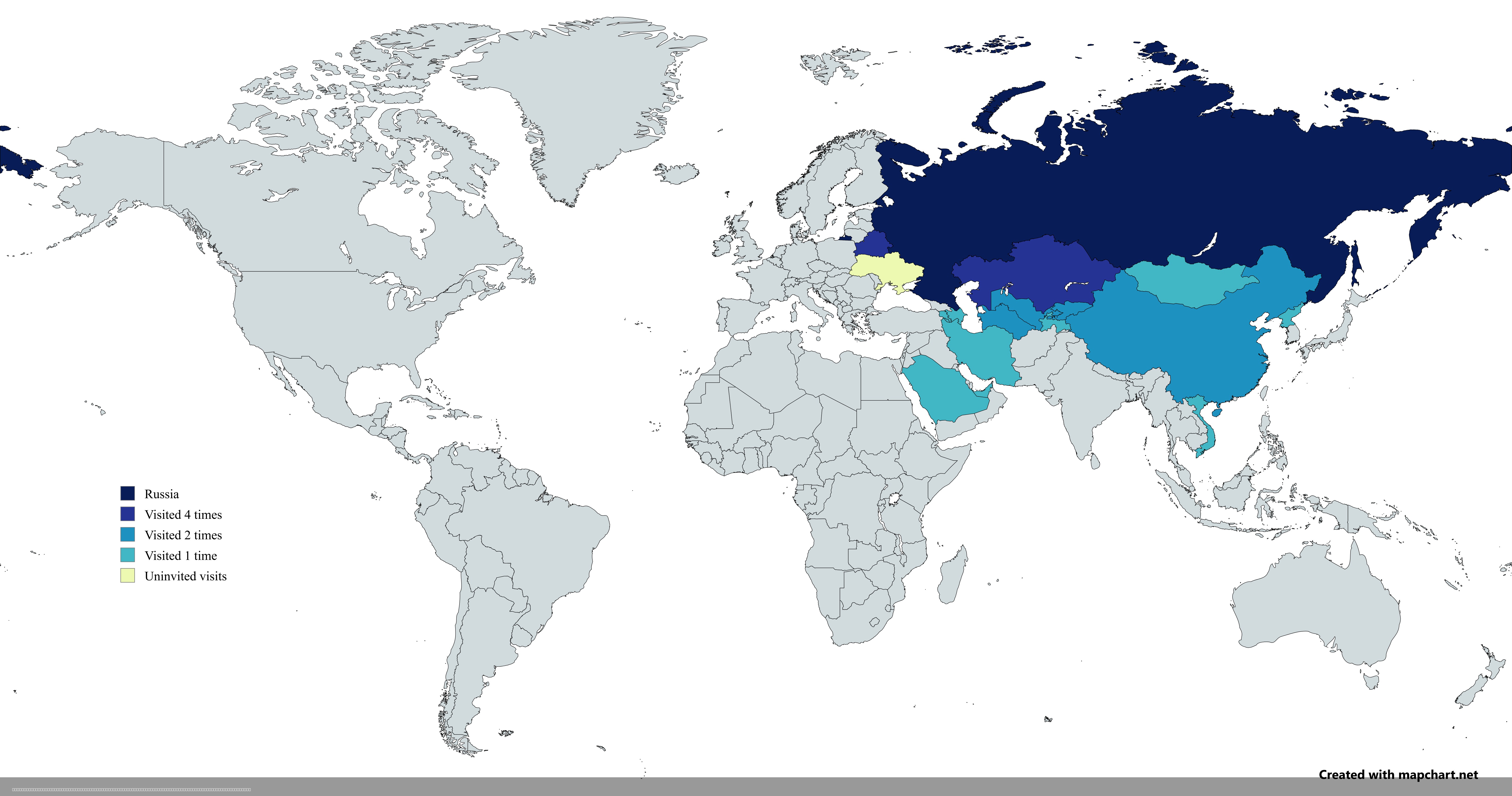Map of Countries Visited by Vladimir Putin Post-2022 Invasion


Alex Cartwright
Senior Cartographer & GIS Specialist
Alex Cartwright is a renowned cartographer and geographic information systems specialist with over 15 years of experience in spatial analysis and data...
Geographic Analysis
What This Map Shows
The map titled "Countries Visited by Russian President Vladimir Putin After the 2022 Russian Invasion of Ukraine" provides a visual representation of the international travels undertaken by Putin following a pivotal moment in global geopolitics. It marks significant trips made by the president since February 2022, illustrating a crucial period in which Russia's relations with various countries have been tested and reshaped. This visualization captures not only the destinations but also hints at the diplomatic engagements and political strategies that have unfolded in the wake of the invasion.
Deep Dive into Putin's Diplomatic Travels
Following the 2022 invasion of Ukraine, the geopolitical landscape has been anything but stable. Putin's travels reflect a strategic pivot in Russia's foreign policy, emphasizing the importance of maintaining alliances and forging new ones. Interestingly, the countries he has visited are often those that either support Russia's actions in Ukraine or hold significant geopolitical importance.
For instance, after the invasion, Putin traveled extensively within the CIS (Commonwealth of Independent States) region, which includes former Soviet republics. This highlights Russia's intent to reinforce its influence over these nations, many of which are economically tied to Moscow. Countries like Belarus and Kazakhstan were among the first stops, reflecting their close ties to Russia. In fact, Belarus, under President Alexander Lukashenko, has been a staunch ally, providing military support and acting as a launch pad for Russian operations in Ukraine.
On the other hand, trips to countries such as China and Iran signal an attempt to strengthen ties with non-Western powers. The relationship with China has been particularly interesting; as both nations face sanctions and scrutiny from the West, they have found common ground in mutual support. For instance, during a visit to Beijing, Putin and Chinese President Xi Jinping emphasized their commitment to a multipolar world, countering Western hegemony. This partnership is not just about politics; it also reflects economic interests, as both countries look to bolster trade and energy agreements amidst global isolation.
Moreover, Putin's trips to countries in Africa, such as Egypt and South Africa, are noteworthy. These visits may seem less significant compared to his engagements with neighboring states, but they underscore Russia's attempts to regain influence in a continent where it has historically been less dominant. The African continent is rich in resources and has been a battleground for international influence, making these trips strategic in nature.
What’s fascinating is how the map illustrates not just the destinations but also the varying levels of reception Putin receives in these countries. While some nations welcome him with open arms, others exhibit a more cautious approach, wary of international backlash. This dynamic creates a complex web of international relations that is continuously evolving.
Regional Analysis
When analyzing the regions represented on the map, it becomes clear that Putin's travel patterns are heavily influenced by geopolitical considerations. In Eastern Europe, countries like Belarus and Serbia have shown strong support for Russia, often echoing Moscow's rhetoric and justifying its actions in Ukraine. Conversely, nations like Poland and the Baltic states have been vocal critics, showcasing a stark division in attitudes toward Russia's actions.
In Central Asia, Putin's visits to Kazakhstan and Uzbekistan highlight the importance of maintaining stability in these countries that are critical to Russia's economic and security interests. Interestingly, Kazakhstan has been balancing its relationships carefully, showing signs of distancing from Moscow while still managing a partnership.
In the Middle East, Russia's increasing presence is marked by visits to Iran and Syria, where geopolitical alliances are often fluid. These trips emphasize Russia's role as a key player in regional conflicts and its support for regimes that align with its interests. The ongoing collaboration with Iran, particularly regarding military and nuclear developments, illustrates a significant shift in alliances that could have global ramifications.
Significance and Impact
The significance of this map extends beyond mere travel; it captures a moment of profound change in international relations. Putin's diplomatic engagements reflect the shifting power dynamics in a post-Cold War world, where alliances are realigned, and new partnerships are forged. These travels show an effort to counterbalance the isolation imposed by Western sanctions and to build a coalition of nations willing to challenge the status quo.
Moreover, understanding these travel patterns can provide insight into future geopolitical trends. As Russia seeks to fortify its standing on the global stage, the implications of these travels will be felt in various sectors, including energy, trade, and military cooperation. As the world watches how these relationships evolve, it poses the question: What will the future of global diplomacy look like in an increasingly multipolar world?
The map serves as a reminder that geography is not just a backdrop for political events, but a fundamental element that shapes global interactions. The countries visited by Putin are not merely dots on a map; they are part of a broader narrative that will define international relations for years to come.
Visualization Details
- Published
- August 7, 2025
- Views
- 116
Comments
Loading comments...